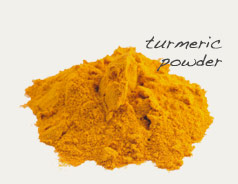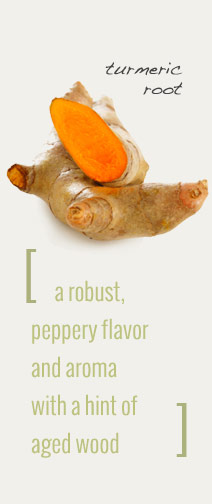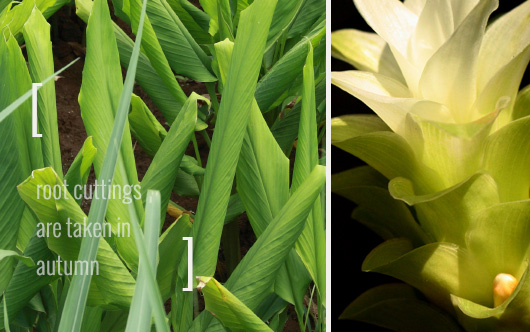turmeric flavor notes
robust, peppery flavor and aroma with a hint of aged wood

culinary uses for turmeric
Whether chopped, sliced, grated or ground, turmeric provides bright color and
imparts a robust, peppery flavor and aroma with a hint of aged wood. It
provides the characteristic golden color of curries and dhal, a type of stew
made from hulled, split lentils or peas. Turmeric is also featured in piccalilli an Indian
chutney, and in kedgeree (pickles), as well as in rice, vegetable and
seafood dishes.
traditional uses for turmeric
yellow on the body
According to Hindu tradition, turmeric is associated with
invoking fertility. Brides are adorned around the neck with a special
thread coated with a paste made from turmeric as marriage vows are made.
A traditional wedding is often preceded by a celebration called
Gaye holud in which family and friends paint elaborate designs on
the bodies of the couple using turmeric paste. This ritual, so
named because it literally means "yellow on the body," illuminates
the skin of the bride and groom with a beautiful golden stain for two
to three days before the nuptials take place. Turmeric is also used
to lend color to the robes of Buddhist monks and doubles as
Natural Yellow No. 3 in the commercial production of mustard, butter,
orange juice and processed cheese.
an early litmus
In the 1870s, chemists discovered turmeric's orange-yellow root powder
turned reddish brown when exposed to alkaline chemicals. This discovery led
to the development of "turmeric paper," thin strips of tissue brushed
with a decoction of turmeric, then dried. During the late 19th century,
turmeric paper was used in laboratories around the world to test for
alkalinity. Eventually, it was replaced by litmus paper, which is still
used today.
American chemists used turmeric paper, but not even the
botanically oriented 19th-century Eclectic physicians had much use for
turmeric itself.

turmeric usable plant parts
roots
farming and processing
Turmeric is a perennial with pulpy, orange, tuberous roots that grow to
about 2 feet in length. The aerial parts, which reach 3 feet, include
large, lily-like leaves, a thick, squat, central flower spike, and
funnel-shaped yellow flowers.
As a member of the Zingiberaceae family, turmeric is related to
ginger. It is also known as Indian saffron because it is similar in
character but a more economical alternative to the real thing.

Formulas & recipes
Turmeric powder uses
Turmeric is becoming an essential household spice in the U.S., though it has been a keystone spice in many Asian cultures for centuries. The plant is closely related to ginger and is native to the wetlands of Southeast Asia. Turmeric powder is mostly used for culinary purposes, adding bright yellow color and distinct spice to any food.
Turmeric is also used as a natural yellow dye and can be used as a safe, household dye for linens, wool, and other textiles. Just boil a large part of water with organic turmeric powder and soak the fabric for at least 8 hours.
Turmeric powder benefits include anti-inflammatory properties and taste. Bulk turmeric powder can be purchased on our website, as well as bulk organic turmeric powder.
What to cook with turmeric
Turmeric is used in a large variety of Indian and Southeast Asian dishes. It is popular to flavor curries with turmeric and a mixture of other spices. It is also used to flavor rice, giving it a brilliant yellow color. Turmeric powder can even be used to make tea and tonics.